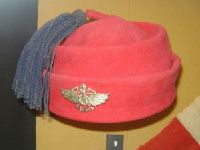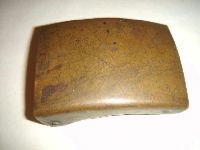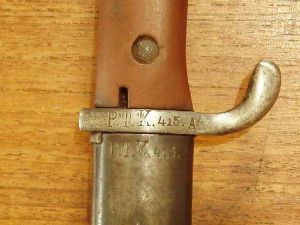| Figure
2 is
based on a photograph of a Polizeitruppe NCO in
Cameroon taken in the
1890's. This was the first
uniform issued to the African Polizeitruppe in
Cameroon. It consisted of a lightweight naval style khaki top with a naval
collar edged in red with red bands on each cuff. Trousers were three
quarter length, in matching lightweight khaki. Curiously this
uniform
was also worn by the German New Guinea Polizeitruppe (see
New Guinea Polizeitruppe
Page). A red sash was worn
by the Cameroon Polizeitruppe around the waist, as was also worn by the Togo
Polizeitruppe. No footwear was worn. Underneath the khaki
top this NCO wears a white naval style shirt with blue edging and three blue bars
across the chest as was also worn by Africans in the Cameroon
Schutztruppe.
The headgear was a red rolled felt fez with a
blue/black tassle and a brass imperial eagle badge on the
front (see right). This was the same as the rolled fez worn by the
Cameroon Schutztruppe, although the Schutztruppe wore a white metal
eagle.
Rank Insignia was worn in the form of
red chevrons on the upper left sleeve (see
NCO Rank Insignia Page),
in this case the NCO is wearing four chevrons indicating he
is a Sergeant Major ("Feldwebel").
The equipment worn is in
brown leather. He carries two ammunition pouches either side of a
blank brass belt buckle (see right). A rolled blanket can just be
seen over his left shoulder, he may also be wearing a backpack
underneath the blanket. Figure 3 is
based on a photograph of the Polizeitruppe in
Cameroon taken in the 1890's. This view shows the rear of
the naval uniform and collar as described above. This Polizei-Soldat
is not wearing the red waist sash usually associated with the
Cameroon and Togo Polizeitruppe. He wears the early style of
ammunition pouches consisting of one large ammunition pouch
centrally located on the front of the belt often with a matching one
on the rear.
Figure
4 is
based on a photograph of the Polizeitruppe in
Cameroon taken in 1903. By this time the naval style top had been
replaced with the same style tunic as worn by the African
Schutztruppe soldiers in Cameroon. It was a pocketless khaki tunic
with four or sometimes (as in this case) five brass (for
Polizeitruppe) buttons down the front. The stand and fall collar was
edged in red and had a single red Litzen-style patch on each side.
The cuffs had a bar of pointed red lace. Unlike the Schutztruppe,
the Polizeitruppe wore the tunic tucked into a red sash around the
waist. This police soldier has neither puttees not boots, but other
photos show the Polizeitruppe in the early 20th century with puttees at least.
|

Cameroon Fez
(See
Imperial War Museum
Collection Page)
IWM Collection

African Soldier's Buckle
(See
Belt Buckles
Details Page)
Photo © Doppler

Cameroon Polizeitruppe kS 98 Bayonet
(See
Bayonets Page)
Photo © Nate Freidlander |







